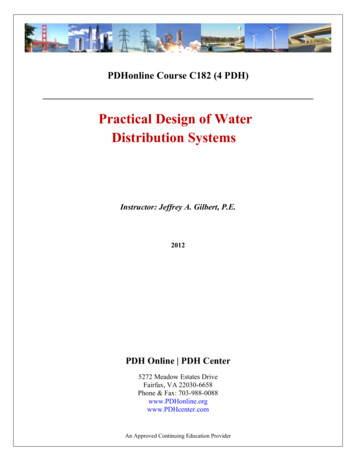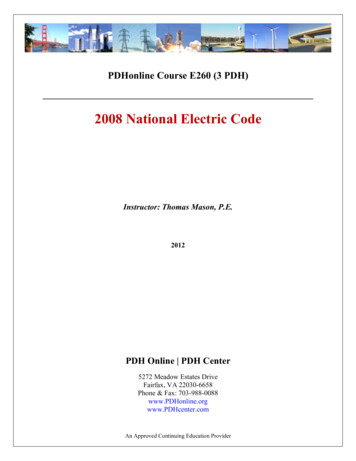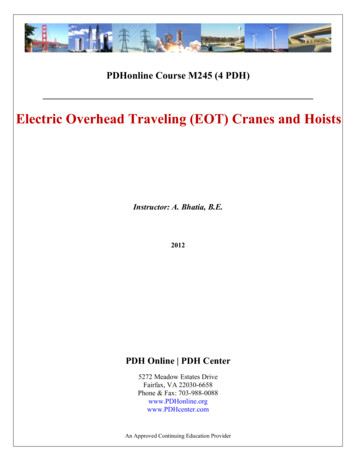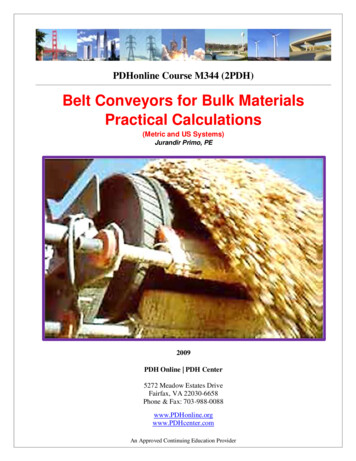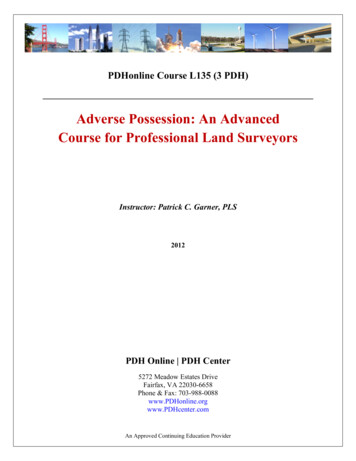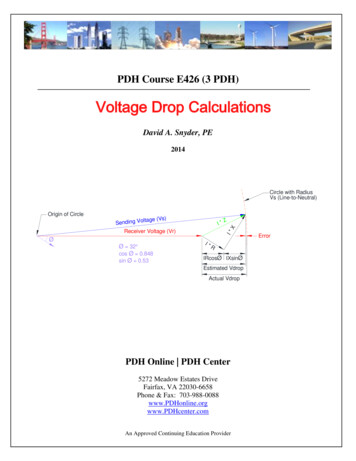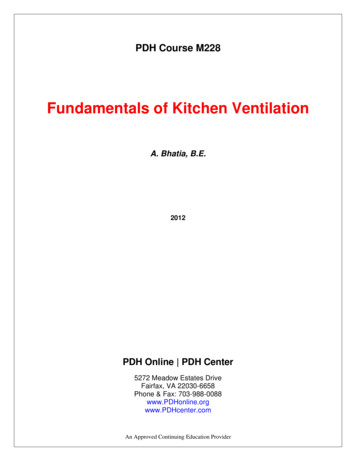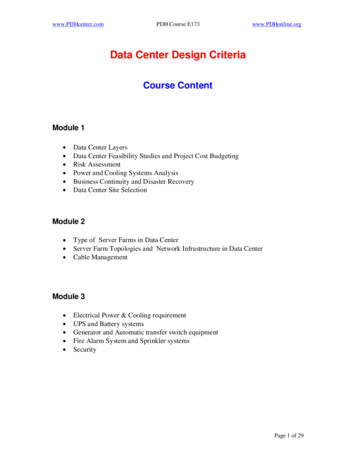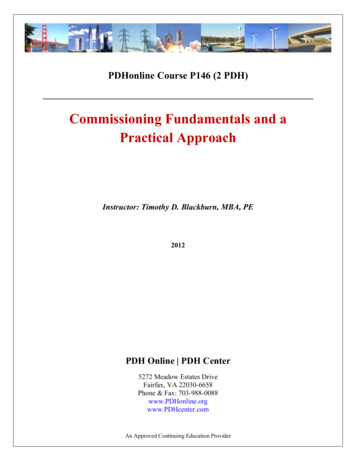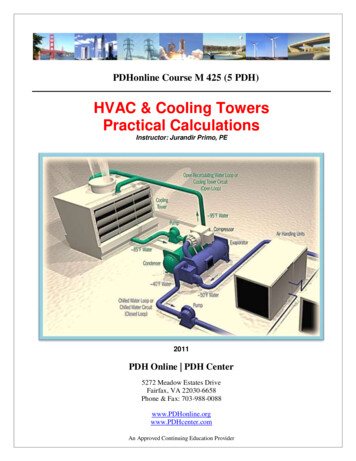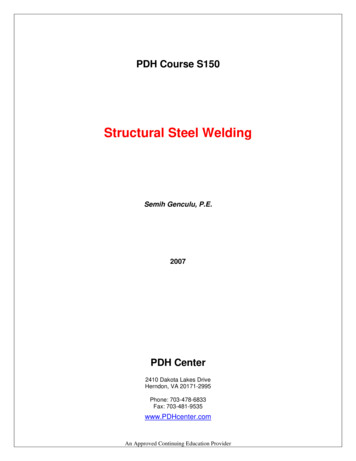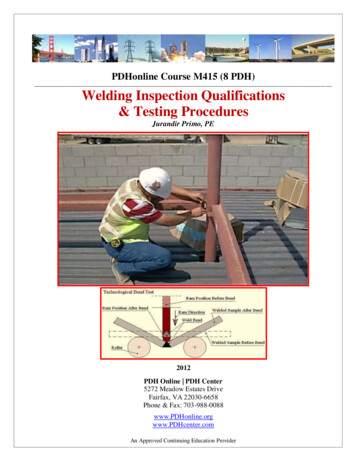
Transcription
PDHonline Course M415 (8 PDH)Welding Inspection Qualifications& Testing ProceduresJurandir Primo, PE2012PDH Online PDH Center5272 Meadow Estates DriveFairfax, VA 22030-6658Phone & Fax: 703-988-0088www.PDHonline.orgwww.PDHcenter.comAn Approved Continuing Education Provider
www.PDHcenter.comPDH Course M415www.PDHonline.orgWELDING INSPECTION QUALIFICATIONS& TESTING PROCEDURESContents:I. INTRODUCTIONII - WELD INSPECTOR KNOWLEDGES:III - WELDING SYMBOLSIV - STANDARDS FOR WELDING POSITIONSV – WELDING PROCESSESVI. WELDING INSPECTION PROCEDURESVII. NONDESTRUCTIVE TESTING (NDT)VIII. DESTRUCTIVE TESTINGIX. WELDING ELECTRODES AND PREHEAT REQUIREMENTSX. CLASSIFICATION OF ELECTRODESXI. WELDING FAILURESXII. WELDING TEST COUPON PROCEDURESXIII. LEAK TESTINGXIV. WELDING EQUIPMENTXVI. WELDING FOR JOISTS AND FINISHING OF MACHINING RAILSXVI. BOILERMAKERXVII. INSPECTION DUTIESXVIII. STANDARD SPECIFICATIONS FOR WELDING PROCEDURESXIX. INSPECTOR CERTIFICATIONSXX. SAFETY AND PRECAUTIONSXXI. WELDER QUALIFICATION RECORDS – SAMPLESXXII. REFERENCES 2012 Jurandir PrimoPage 2 of 116
www.PDHcenter.comPDH Course M415www.PDHonline.orgI – INTRODUCTION:The main objective of this manual is to bring a resume of the most common subjects that generallymatter in daily welding inspections, tailored for students, welders, technicians, welding inspectors andengineers in a practical way that anyone can research some subject in a timely manner to carry awork, without wasting too much his precious time.Metallurgy is not the scope and is limited in selecting welding processes, materials, and inspectionprocedures for the common construction applications.Weld inspection serves as a quality control on fabrication, welding operations and weldingprocedures. Records of how often various types of defects occur, must show when changes in weldingprocedures are necessary, detecting poor welding practices or when the welders or welding operatorsshould be re-qualified.The Welding Inspector must judge whether the weldments inspected are conform to the specificationsand the quality criteria defined in drawings, applicable specifications and welding standards. Theinspector must know the limitations of the testing methods, materials, basic metallurgy, heattreatments, procedures and all types of fabrication processes.Nondestructive personnel must be qualified according to ASNT (American Society for NondestructiveTesting) according to ASNT SNT-TC-1A. A responsible manufacturer depends entirely on inspectionrecords to correct problems soon enough to prevent the lost time of frequent repairs.II - WELDING INSPECTOR KNOWLEDGES:The Welding Inspector must be a high skilled technician or engineer with a good knowledge of generalindustry manufacture, materials, quality systems, inspection procedures and standards as:Standard organizations as ASTM, SAE, AISI, AWS, ASME and other institutions;Metals metallurgy, hardness tests and heat treatment;Materials properties, destructive testing and NDT methods;Terminology, weld joint geometry and welding symbols;Welding equipment, metal joining and cutting processes;Application of procedures, records, welding inspection and qualifications;Evaluation of weld and base metal discontinuities;Metric and conversion practices;Safe welding practices;1. Standards and Specifications:The professional and industrial organizations in the United States that lead the development ofstandards include: the ASTM International, the Society of Automotive Engineers (SAE), the AmericanIron and Steel Institution (AISI), the American Welding Society (AWS) and the ASME International.Many specifications have also been developed by US government agencies suchas the Department of Defense (DOD). However, the US government is revisingits specification and many specifications are being controlled by diverseindustrial groups.The MIL-I-25135 has historically been the controlling document for militaryuses, but recent change in military specification management, was incorporatedinto SAE's AMS 2644. Thousands of standard specifications are recognized bythe American National Standards Institute (ANSI), which is a national, private,coordinating agency. 2012 Jurandir PrimoPage 3 of 116
www.PDHcenter.comPDH Course M415www.PDHonline.orgThe International Organization for Standardization (ISO) also performs this functi on, formed in 1947,as a non-governmental federation of standardization bodies from over 60 countries. The links of thespecification organizations are indicated below:American Society for Testing and Materials:ASTM standards: Founded in 1898, ASTM International is a not-for-profit organization that providesa global forum for the development and publication of voluntary consensusstandards for materials, products, systems, and services.The American Society for Testing and Materials, ASTM International providesstandards that are accepted and used in research and development, producttesting, quality systems, and commercial transactions around the globe.Over 30,000 individuals from 100 nations are the members of ASTM International,who are producers, users, consumers, and representatives of government. In over130 varied industry areas, ASTM standards serve as the basis for manufacturing,procurement, and regulatory activities.Each year, ASTM publishes the Annual Book of ASTM Standards, which consists ofapproximately 70 volumes. Most of the NDT related documents can be found inVolume 03.03, Nondestructive Testing. E-03.03 is under the jurisdiction of ASTMCommittee E-7.Each standard practice or guide is the direct responsibility of a subcommittee. Forexample, document E-94 is the responsibility of subcommittee E07.01 onRadiology (x and gamma) Methods.The Society of Automotive Engineers:SAE standards:The Society of Automotive Engineers is a professional society that serves asresource for technical information used in designing, building, maintaining, andoperating self-propelled vehicles for use on land or sea, in air or space.Over 83,000 engineers, business executives, educators, and students from morethan 97 countries form the memberships who share information for advancing theengineering of mobile systems. SAE is responsible for developing several differentdocuments for the aerospace community.These documents include: Aerospace Standards (AS), Aerospace MaterialSpecifications (AMS), Aerospace Recommended Practices (ARP), AerospaceInformation Reports (AIR) and Ground Vehicle Standards (J-Standards).The documents are developed by SAE Committee K members, which are technicalexperts from the aerospace community.American Society of Mechanical Engineers:ASME International was founded in 1880 as the American Society of MechanicalEngineers. It is a nonprofit educational and technical organization serving aworldwide membership of 125,000.ASME Standards:ASME maintains and distributes 600 codes and standards used around the world forthe design, manufacturing and installation of mechanical devices. One of thesecodes is called the Boiler and Pressure Vessel Code. 2012 Jurandir PrimoPage 4 of 116
www.PDHcenter.comPDH Course M415www.PDHonline.orgThis code controls the design, inspection, and repair of pressure vessels. Inspectionplays a big part in keeping the components operating safely. More information aboutthe B&PV Code can be found at the links to the left.The American Welding Society:The American Welding Society (AWS) was founded in 1919 as a multifaceted,nonprofit organization with a goal to advance the science, technology andapplication of welding and related joining disciplines.AWS Standards:AWS serves 50,000 members worldwide. Membership consists of engineers,scientists, educators, researchers, welders, inspectors, welding foremen, companyexecutives and officers, and sales associates.The International Organization for Standardization:The International Organization for Standardization (ISO) was formed in 1947 as anon-governmental federation of standardization bodies from over 60 countries.ISO Standards:The ISO is headquartered in Geneva, Switzerland. The Unites States is representedby the ANSI.The Aerospace Industries Association:AIA Standards:The Aerospace Industries Association represents the nation's major manufacturers ofcommercial, military and business aircraft, helicopters, aircraft engines, missiles,spacecraft, materials, and related components and equipment.The AIA has been an aerospace industry trade association since 1919. It wasoriginally known as the Aeronautical Chamber of Commerce (ACCA). The AIA isresponsible for two NDT related documents, which are:NAS 410, Certification & Qualification Of Nondestructive Test Personnel. Thisdocument is widely used in the aerospace industry as it replaces MIL-STD-410E.Military Standard, Nondestructive Testing Personnel Qualification and Certification.NAS 999, Nondestructive Inspection of Advanced Composite Structure.The American National Standards Institute:ANSI Standards: ANSI is a private, nonprofit organization that administers and coordinates the USvoluntary standardization and conformity assessment system.The Institute's mission is to enhance both the global competitiveness of US businessand the US quality of life by promoting and facilitating voluntary consensus standardsand conformity assessment systems, and safeguarding their integrity.The American Society for Nondestructive Testing:ASNT Standards: The American Society for Nondestructive Testing offers certification in NDT, withmembership over 12,000, including affiliation more than 500 companies. With ASNTcomes access to thousands of NDT practitioners throughout the world working inmanufacturing, construction, education, research, consulting, services and the military.NDT Certifications according to ASNT/SNT-TC-1A. 2012 Jurandir PrimoPage 5 of 116
www.PDHcenter.comPDH Course M415www.PDHonline.org2. Materials – Fundamentals:The structure of materials is classified by the general features being considered. The three mostcommon major classification of structural, listed generally in increasing size, are:Atomic structure: includes features that cannot be seen, such as the types of bondingbetween the atoms, and the way the atoms are arranged;Microstructure: includes features that can be seen using a microscope, but seldom with thenaked eye;Macrostructure: which includes features that can be seen with the naked eye)?The atomic structure primarily affects the chemical, physical, thermal, electrical, magnetic, andoptical properties. The microstructure and macrostructure can also affect these properties but theygenerally have a larger effect on mechanical properties and on the rate of chemical reaction.From the periodic table, it can be seen that there are only about 100 different kinds of atoms in theentire Universe. These same 100 atoms form thousands of different substances ranging from the airwe breathe to the metal used to support tall buildings.Metals behave differently than ceramics, and ceramics behave differently than polymers. Theproperties of matter depend on which atoms are used and how they are bonded together. Theproperties of a material offer clues as to the structure of the material. The strength of metalssuggests that these atoms are held together by strong bonds. However, these bonds must also allowatoms to move since metals are also usually formable.3. Basic Concepts of Materials Structure:Thousands of materials available for use in engineering applications fall into one of three classes thatare based on the atomic bonding forces of a particular material. These classifications are metallic,ceramic and polymeric. 2012 Jurandir PrimoPage 6 of 116
www.PDHcenter.comPDH Course M415www.PDHonline.orgDifferent materials can be combined to create a composite, further organized into groups based ontheir chemical composition or certain physical or mechanical properties.These composite materials are grouped by combined types, the way the materials are arrangedtogether. The list of some of the commonly classification of materials is:a. Metallic:Ferrous metals and alloys - (irons, carbon steels, alloy steels, stainless steels, tool and die steels)Nonferrous metals and alloys - (aluminum, copper, magnesium, nickel, titanium, precious metals,refractory metals and super alloys).b. Polymeric:Thermoplastics plasticsThermoset plasticsElastomersc. Composites:Reinforced plasticsMetal-matrix compositesCeramic-matrix compositesSandwich structuresConcreteObs.: Other special materials as ceramics, glasses, glass ceramics, graphite, diamond, etc.3.1. Physical and Chemical Properties:Physical properties can be observed without changing the identity of the substance. The generalproperties of matter such as color, density, hardness, are examples of physical properties.Properties that describe how a substance changes into a completely different substance are calledchemical properties. Flammability, corrosion, wear and oxidation resistance are examples of chemicalproperties in several types of alloys.The difference between a physical and chemical property is straightforward until the phase of thematerial is considered. When a material changes from a solid to a liquid to a vapor it seems like thembecome a difference substance.When a material melts, solidifies, vaporizes, condenses or sublimes, only the state of the substancechanges. Phase is a physical property of matter in four phases – solid, liquid, gas and plasma.3.2. Phase Transformation Temperatures:DensitySpecific GravityThermal ConductivityLinear Coefficient of Thermal ExpansionElectrical Conductivity and ResistivityMagnetic PermeabilityCorrosion ResistanceWear Resistance 2012 Jurandir PrimoPage 7 of 116
www.PDHcenter.comPDH Course M415www.PDHonline.org3.3. Metals:Metals account for about two thirds of all the elements and about 24% of the mass of the planet.Metals have useful properties including strength, ductility, high melting points and toughness. Fromthe periodic table, it can be seen that a large number of the elements are classified as metal. A few ofthe common metals and their typical uses are presented below:3.4. Common Metallic Materials:Iron/Steel - Steel alloys are used for strength critical applications.Aluminum - Aluminum and its alloys are used because they are easy to form, readily available,inexpensive, and recyclable.Copper - Copper and copper alloys have a number of properties that make them useful, includinghigh electrical and thermal conductivity, high ductility, and good corrosion resistance.Titanium - Titanium alloys are used for strength in higher temperature ( 1000 F), when componentweight is a concern, or when good corrosion resistance is required.Nickel - Nickel alloys are used for still higher temperatures ( 1500-2000 F) or when good corrosionresistance is required.3.5. Refractory Materials:These materials are used for the highest temperature ( 2000 F) applications. The main feature thatdistinguishes metals from non-metals is their bonding. Metallic materials have free electrons thatare free to move easily from one atom to the next.The free electrons have a number of profound consequences for the properties of metallic materials.It is known that metallic materials tend to be good electrical conductors because the free electronscan move around within the metal so freely. 2012 Jurandir PrimoPage 8 of 116
www.PDHcenter.comPDH Course M415www.PDHonline.org4. Steel Production:Steel is an alloy of iron usually containing less than 1.5% carbon. Steel can be cast into bars,strips, sheets, nails, spikes, wire, rods or pipes as needed by the intended user. Steel production atan integrated steel plant involves three basic steps. First, the heat source used to melt iron ore isproduced. Next the iron ore is melted in a furnace. Finally, the molten iron is processed to producesteel. The fuel source is often purchased from off-site producers.Steel is made by the Bessemer, Siemens Open Hearth, Basic Oxygen Furnace, Electric Arc, ElectricHigh-frequency and Crucible processes. In the former processes, molten pig iron is refined byblowing air through it in an egg-shaped vessel, known as a converter.In the Siemens process, both acid and basic, the necessary heat for melting and working the chargeis supplied by oil or gas.Coke is a solid carbon fuel and carbon source used to melt and reduce iron ore. Coke productionbegins with pulverized, bituminous coal, produced in batch processes, with multiple coke ovensoperating simultaneously.Heat is frequently transferred from one oven to another to reduce energy requirements. After thecoke is finished, it is moved to a quenching tower where it is cooled with water spray. Once cooled,the coke is moved directly to an iron melting furnace or into storage for future use.During iron making, iron ore, coke, heated air and limestone or other fluxes are fed into ablast furnace. The heated air causes the coke combustion, which provides the heat and carbonsources for iron production.Limestone or other fluxes may be added to react with and remove the acidic impurities, called slag,from the molten iron. The limestone-impurities mixtures float to the top of the molten iron and areskimmed off, after melting is complete. 2012 Jurandir PrimoPage 9 of 116
www.PDHcenter.comPDH Course M415www.PDHonline.orgSintering products may also be added to the furnace. Sintering is a process in which solid wastes arecombined into a porous mass that can then be added to the blast furnace. These wastes include ironore fines, pollution control dust, coke breeze, water treatment plant sludge, and flux.Sintering plants help reduce solid waste by combusting waste products and capturing trace ironpresent in the mixture. Sintering plants are not used at all steel production facilities.Molten iron from the blast furnace is sent to a basic oxide furnace, which is used for the finalrefinement of the iron into steel. High purity oxygen is blown into the furnace and combusts carbonand silicon in the molten iron. The basic oxide furnace is fed with fluxes to remove any final impuritiesand alloy materials may be added to enhance the characteristics of the steel.The resulting steel is most often cast into slabs, beams or billets. Further shaping of the metalmay be done at steel foundries, which re-melt the steel and pour it into molds, or at rolling facilities,depending on the desired final shape.Coke production is one of the major pollution sources from steel production. Air emissions such ascoke oven gas, naphthalene, ammonium compounds, crude light oil, sulfur and coke dust are releasedfrom coke ovens.Cokeless iron making procedures are currently being studied and, in some places, implemented.One such procedure is the Japanese Direct Iron Ore Smelting (DIOS) process. The DIOS processproduces molten iron from coal and previously melted ores. In this process, coal and other ores canproduce enough heat to melt ore, replacing coke completely.A final coke less iron melting process is the Corex or Cipcor Process. This process also manipulatescoke to produce the heat required to melt iron. A Corex plant is operational in South Africa. Korea hasa Corex plant operating at 70% capacity in 1996, expected to continue in progress.The process integrates coal desulfurization, has flexible coal-type requirements, and generatesexcess electricity that can be sold to power grids. Further testing is being conducted in the U.S todetermine commercial feasibility.Iron carbide production plants are an alternative to the Basic Oxide Furnace. These plants use ironcarbide, an iron ore that contains 6% carbon rather than 1.5-1.8% of regular iron ore. The additionalcarbon ignites in the presence of oxygen and contributes heat to the iron melting process, reducingenergy requirements. 2012 Jurandir PrimoPage 10 of 116
www.PDHcenter.comPDH Course M415www.PDHonline.orgSteelmaking from scrap metals involves melting scrap metal, removing impurities and casting itinto the desired shapes. Electric arc furnaces (EAF) are often used. The EAF s melt scrap metal in thepresence of electric energy and oxygen.The process does not require the three step refinement as needed to produce steel from ore.Production of steel from scrap can also be economical on a much smaller scale. Frequently millsproducing steel with EAF technology are called mini-mills.EOF was developed to replace the electric arc and other steelmaking furnaces. The Electric OxygenFurnace (EOF) is an oxygen steelmaking process. Carbon and oxygen react to preheat scrap metal,hot metal and/or pig iron.These furnaces reduce capital and conversion costs, energy consumption and environmentalpollution, while increasing input flexibility.After the molten metal is released from the BOF, EAF or EOV, it must be formed into its final shapeand finished to prevent corrosion. Traditionally, steel was poured into convenient shapes called ingotsand stored until further shaping was needed.Current practices are continuous in casting methods, where the steel is poured directly into semifinished shapes. Continuous casting saves time by reducing the steps required to produce thedesired shape.After the steel has cooled in its mold, continued shaping is done with hot or cold forming. Hotforming is used to make slabs, strips, bars or plates from the steel. Heated steel is passed betweentwo rollers until it reaches the desired thickness.4.1 Metal Forming:Cold forming is used to produce wires, tubes, sheets and strips. In this process the steel ispassed between two rollers, without being heated, to reduce the thickness. The steel is then heated inan annealing furnace to improve the ductile properties.Cold rolling is more time consuming, but the products have better mechanical properties, bettermachinability, and can be more easily manipulated into special sizes and thinner gauges.After rolling is completed, the steel pieces are finished to prevent corrosion and improveproperties of the metal.4.2. Sheet Metal:Sheet metal is simply metal formed into thin and flat pieces. It is one of the fundamental formsused in metalworking, and can be cut and bent into a variety of different shapes. Thicknesses canvary significantly, although extremely thin thicknesses are considered foil or leaf, and pieces thickerthan 6 mm (0.25 in) are considered plate.Sheet metal is available in flat pieces or as a coiled strip. The coils are formed by running acontinuous sheet of metal through a roll slitter. The thickness of the sheet metal is calledits gauge.Commonly used steel sheet metal ranges from 30 gauges to about 8 gauges. The larger thegauge number, the thinner the metal.Sheet metal also has applications in car bodies, airplane wings, medical tables, roofs for buildings(architectural) and many other things. 2012 Jurandir PrimoPage 11 of 116
www.PDHcenter.comPDH Course M415www.PDHonline.orgSheet metal of iron and other materials with high magnetic permeability, also known as laminatedsteel cores has applications in transformers and electric machines. Below there is a simplerepresentation of metal transformation.4.3. Steel Pipes Manufacturing:Steel pipes, tubes or ducts are manufactured from mild steel strips are cut from Hot Rolled LowCarbon Steel coils, as shown below: 2012 Jurandir PrimoPage 12 of 116
www.PDHcenter.comPDH Course M415www.PDHonline.orgThe strip passes through a series of drive forming and fin rolls and takes the required circularshape and is welded continuously by passage of an electric current of high frequency, i.e., 50,000cycles/second across the abutting edges.The steel pipes tubes thus formed and welded pass through the sizing sections where dimensionaldeviations if any are corrected before the tubes are cut into required length by automatic cuttingmachines. The tubes are then end deburred and pressure tested.Thereafter protective surface finishing operations such as Hot Dip Galvanizing or varnishing is done asper specific requirement. The tubes are offered as plain, beveled, threaded ends or with flanges.4.4. Foundry:A foundry is a factory that produces metal castings. Metals are cast into shapes by melting theminto a liquid, pouring the metal in a mold, and removing the mold material or casting after the metalhas solidified as it cools.The most common metals processed are aluminum andcast iron. Other metals, such as bronze, steel,magnesium, copper, tin and zinc are also used toproduce castings in foundries.Melting is performed in a furnace mixing virginmaterial, external scrap, internal scrap, and alloyingelements to charge the furnace. Virgin material refers tocommercially pure forms of the primary metal used toform a particular alloy.Alloying elements are either pure forms of an alloying element, like electrolytic nickel or alloys oflimited composition, such as ferroalloys or master alloys. External scrap is material from otherforming processes such as punching, forging, or machining. Internal scrap consists ofthe gates, risers, or defective castings.The process includes melting the charge, refining the melt, adjusting the melt chemistry and tappinginto a transport vessel. Refining is done to remove deleterious gases and elements from the moltenmetal to avoid casting defects.4.4.1. Furnace:Several specialized furnaces are used to melt the metal. Modern furnace types include Electric ArcFurnaces (EAF), induction furnaces, cupolas, reverberators, and crucible furnaces. Furnaces arerefractory lined vessels that contain the material to be melted and provide the energy to melt it.Furnace choice is dependent on the alloy system and quantities produced. Reverberators and cruciblefurnaces are common for producing aluminum castings. In the case of aluminium alloys, a degassingstep is usually necessary to reduce the amount of hydrogen in the liquid metal.If the hydrogen concentration in the melt is too high, the resulting casting will contain gas porositythat will deteriorate its mechanical properties. For low temperature melting point alloys, such as zincor tin, melting furnaces may reach around 327 Celsius. Electricity, propane, or natural gas isusually used for these temperatures.For high melting point alloys such as steel or nickel based alloys, the furnace must be designed fortemperatures over 1600 Celsius. The fuel used to high temperatures can be electricity or coke. 2012 Jurandir PrimoPage 13 of 116
www.PDHcenter.comPDH Course M415www.PDHonline.org4.4.2. Mold Making:In the casting process a pattern is made in the shape of the desired part. This pattern is made outof wax, wood, plastic or metal. Simple designs can be made in a single piece or solid pattern. Morecomplex designs are made in two parts, called split patterns.A split pattern has a top or upper section, called a cope, and a bottom or lower section called a drag.Both solid and split patterns can have cores inserted to complete the final part shape.These mold processes include:Sand casting — Green or resin bonded sand mold.Lost-foam casting — Polystyrene pattern with a mixture of ceramic and sand mold.Investment casting — Wax or similar sacrificial pattern with a ceramic mold.Ceramic mold casting — Plaster mold.V-process casting — Vacuum is used in conjunction with thermoformed plastic to form sandmolds. No moisture, clay or resin is needed for sand to retain shape.Die casting — Metal pattern.Billet (ingot) casting — Simple mold for producing ingots of metal normally for use in otherfoundries.4.4.3. Pouring:In a foundry, molten metal is poured into molds. Pouring can beaccomplished with gravity, or it may be assisted with a vacuum orpressurized gas.Many modern foundries use robots or automatic pouring machines forpouring molten metal. Traditionally, molds were poured by handusing ladles.4.4.4. Finishing:The final step in the process usually involves grinding, sanding, or machining the component inorder to achieve the desired dimensional accuracies, physical shape and surface finish.Removing the remaining gate material, called a gate stub, is usually done using a grinder or sanding.These processes are used because their material removal rates are slow enough to control theamount of material. These steps are done prior to any final machining.After grinding, any surfaces that require tight dimensional control are machined. Many castingsare machined in CNC milling centers. The reason for this is that these processes have betterdimensional capability and repeatability than many casting processes.Painting components to prevent corrosion and improve visual appeal is common. Some foundries willassemble their castings into complete machines or sub-assemblies. Other foundries weld multiplecastings or wrought metals together to form a finished product.4.5. Forging:Forging is a manufacturing process involving the shaping of metal using localized compressiveforces. Forging is often classified according to the temperature: "cold", "warm", or "hot" forging.Forged parts can range in weight from less than a kilogram to 580 metric tons. Forged parts usuallyrequire further processing to achieve a finished part. 2012 Jurandir PrimoPage 14 of 116
www.PDHcenter.comPDH Course M415www.PDHonline.orgHot metal ingots being loaded into a hammer forge.Some metals may be forged cold, but iron and steel are almost always hot forged. Hot forgingprevents the work hardening that would result from cold forging, which would increase the difficultyof performing secondary machining operations on the piece.While work hardening may be desirable in some circumstances, other methods of hardening thepiece, such as heat treating, are generally more economical and more controllable. Alloys that areamenable to precipitation hardening, such as most aluminium alloys and titanium, can be hot forged,followed by hardening.A forging press, often just called a press, is used for press forging. There are two main types, themechanical and hydraulic presses:Mechanical presses - function by using cams, cranks and/or toggles to produce a preset (apredetermined force at a
Weld inspection serves as a quality control on fabrication, welding operations and welding procedures. Records of how often various types of defects occur, must show when changes in welding procedures are necessary, detecting poor welding practices or when the welders or
